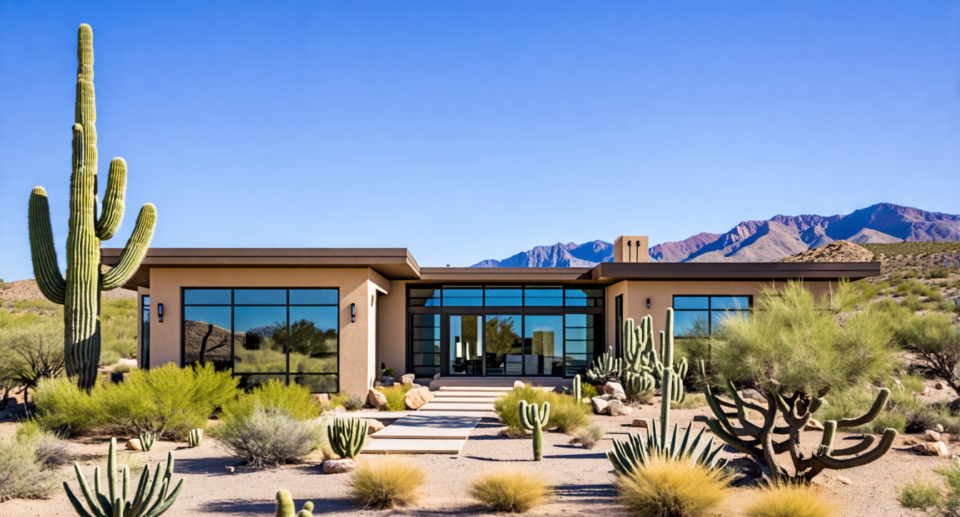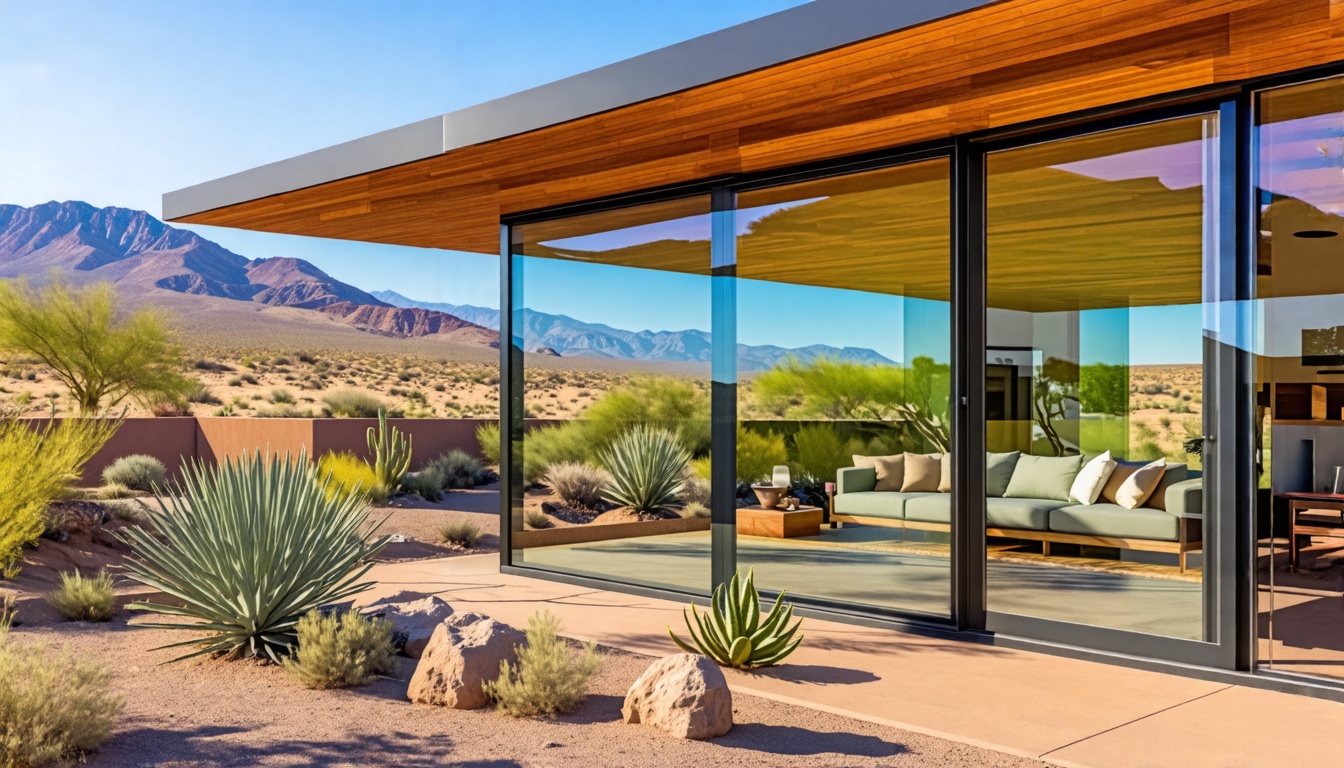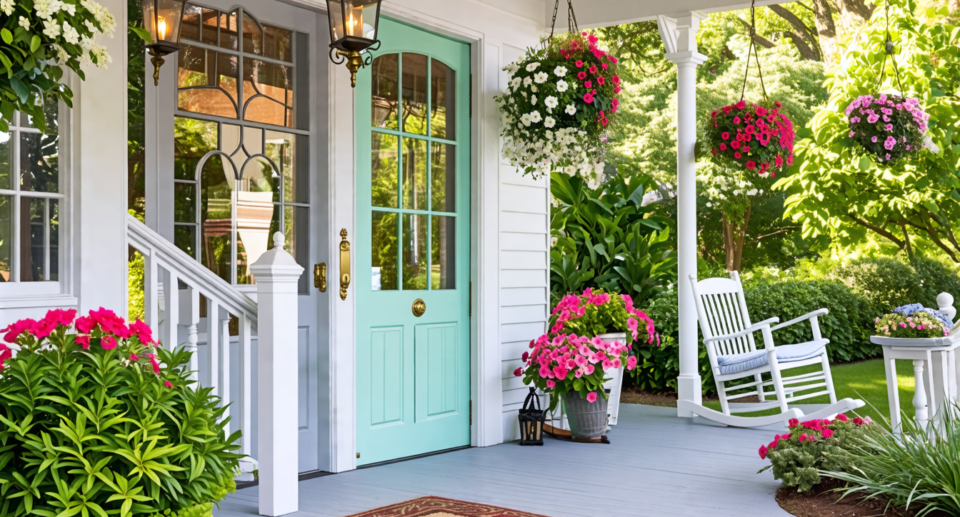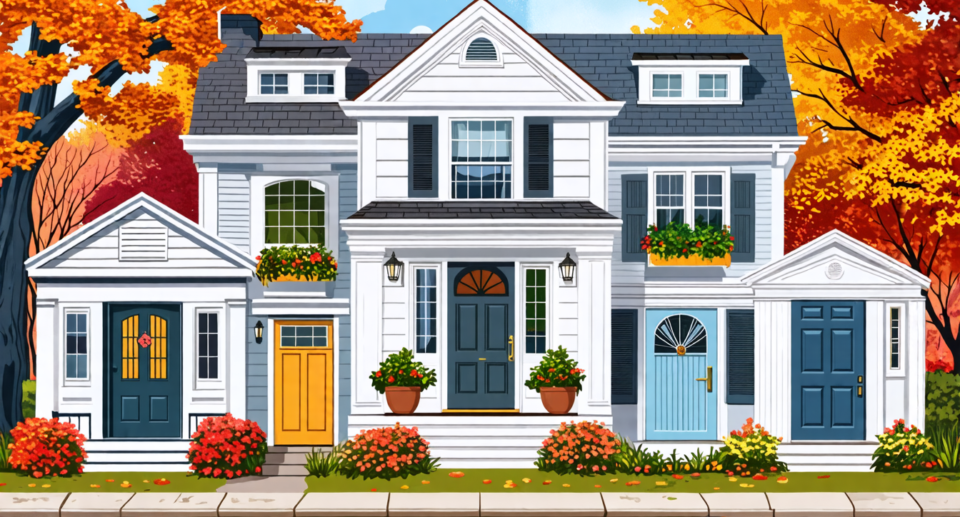Desert-Ready Windows: Best Choices for Southwest U.S. Homes

Table of Contents
ToggleLiving in the Southwest U.S. comes with its own set of unique challenges, particularly when it comes to home maintenance and energy efficiency. One crucial aspect often overlooked is the importance of choosing the right windows that can withstand the harsh desert conditions.
In regions characterized by soaring temperatures, relentless UV exposure, and frequent dust storms, selecting windows that are both durable and energy-efficient is essential for maintaining a comfortable indoor environment. Not only can the right windows provide significant savings on energy bills, but they also safeguard the longevity and functionality of your home.
This article delves into the best choices for desert-ready windows, guiding you through the key features to consider and highlighting the top brands and products that are ideal for Southwest U.S. homes.
Whether you’re looking to upgrade your existing windows or planning a new construction project, understanding what makes a window suited for desert climates will ensure you make an informed decision that combines durability, efficiency, and style.
Introduction to Desert-Ready Windows
Choosing the right windows for homes in the Southwest U.S. is crucial for maintaining comfort, energy efficiency, and durability. The harsh desert climate in this region poses unique challenges that standard windows may not be equipped to handle.
Investing in desert-ready windows can significantly enhance your home’s performance and resilience in facing these extreme conditions.
Importance of Choosing the Right Windows for Southwest U.S. Homes
The Southwest U.S. is known for its beautiful landscapes and warm weather, but the climate can be particularly demanding on buildings and their components, especially windows. Poorly suited windows can lead to increased energy costs, decreased comfort, and rapid deterioration.
Therefore, selecting windows designed specifically for desert environments is essential.
Desert-ready windows offer benefits such as improved insulation, better UV protection, and enhanced durability. These attributes not only contribute to a more comfortable indoor environment but also extend the lifespan of the windows themselves, making them a cost-effective choice in the long run.
By reducing the need for frequent replacements and minimizing maintenance, homeowners can enjoy both economic and practical advantages.
Unique Climate Challenges in Desert Regions
Desert regions, particularly in the Southwest U.S., present a set of environmental stressors that can test the structural integrity and functional capacity of windows. Understanding these challenges is the first step in making an informed decision about the type of windows suitable for desert homes.
High Temperatures
One of the most significant climate challenges in desert regions is the high temperatures, often soaring above 100°F (38°C) during the summer months. Windows in such locations must be capable of providing excellent thermal insulation to maintain a comfortable indoor temperature without overworking the cooling systems.
Without proper insulation, homes can experience intense heat gains, leading to skyrocketing energy bills and an uncomfortable living environment.
UV Exposure
Intense UV radiation is another concern in desert climates. Prolonged exposure to UV rays can cause damage to furnishings, flooring, and even the windows themselves. Over time, UV exposure can result in fading of interior decor and degradation of window materials.
Therefore, windows with advanced UV protection are crucial to shielding both your home’s interior and the windows from harmful effects.
Dust Storms
Desert regions are also prone to dust storms, which can lead to significant wear and tear on windows. These storms carry abrasive particles that can scratch and damage glass surfaces and window frames.
Windows in desert homes need to be robust enough to withstand frequent dust exposure while providing a tight seal to keep dust from entering the home. Windows that fail to do so can result in poor air quality indoors and increased maintenance efforts.
Selecting desert-ready windows is not merely an option but a necessity for homeowners in the Southwest U.S. The right choice in windows helps tackle the unique climate challenges, ensuring that homes remain energy-efficient, comfortable, and safeguarded against the elements.
In the following sections, we will explore the top features to look for in desert-resistant windows and review some of the best window brands and products designed specifically for such demanding conditions.

Top Features to Look for in Desert-Resistant Windows
Insulation and Energy Efficiency
One of the most critical features to consider in desert-resistant windows is their insulation and energy efficiency. With the Southwest U.S. experiencing extreme heat, having windows that reduce heat transfer and improve energy efficiency is a necessity. This is where Low-E glass, double/triple glazing, and argon/krypton gas fills come into play.
Low-E Glass: Low-Emissivity (Low-E) glass has a special coating designed to minimize the amount of infrared and ultraviolet light that comes through your glass, without compromising the amount of visible light transmitted. This coating helps to keep heat out during the scorching summers, making Low-E glass an excellent choice for desert homes.
Double/Triple Glazing: Dual and triple glazed windows consist of two or three panes of glass separated by spacers, which provide an additional barrier against the external temperature. This significantly reduces heat transfer, keeping your home cooler and lessening the load on air conditioning systems. Homes in desert climates will benefit greatly from triple glazing, as it offers superior insulation compared to single or double glazing.
Argon/Krypton Gas Fills: The spaces between the panes in double or triple glazed windows can be filled with inert gases like argon or krypton. These gases have a higher density than air and lower thermal conductivity, which improves the thermal insulation. Opting for windows with argon or krypton gas fills is an effective way to enhance energy efficiency and maintain comfortable indoor temperatures in desert regions.
UV Protection
The intense sunlight in desert regions means that UV protection is another crucial feature to look for in your windows. Prolonged exposure to UV rays can cause significant damage to furniture, flooring, and other interior elements. Therefore, selecting windows that offer robust UV protection is essential.
Tinted Glass: Tinted glass can reduce the amount of UV rays that penetrate through the windows. This glass is treated to reflect and absorb more sunlight, which not only protects your interiors but also helps in maintaining cooler indoor temperatures.
Spectrally Selective Coatings: Spectrally selective coatings are advanced window coatings that are designed to filter out specific wavelengths of light. They are highly effective at blocking UV rays and reducing heat gain while allowing in ample natural light. These coatings are especially beneficial in desert climates, where sun exposure is intense and constant.
Laminated Glass Options: Laminated glass consists of two layers of glass with a layer of plastic in between. This structure provides excellent UV protection as it can block up to 99% of UV rays. Additionally, laminated glass offers increased safety and security, making it a valuable feature for homes in dust-prone, windy desert areas.
Durability and Maintenance
Durability and low maintenance are vital attributes for windows in desert climates. The harsh environmental conditions, including extreme heat, dust storms, and potential corrosion, necessitate the use of resilient materials that can withstand these challenges with minimal upkeep.
Vinyl Frames: Vinyl is an excellent material for window frames in desert regions due to its resistance to heat, warping, and corrosion. Vinyl frames do not require painting or frequent maintenance, making them a convenient and durable choice for homeowners. Additionally, vinyl frames are energy-efficient, providing good insulation properties which help to keep your home cooler.
Fiberglass Frames: Fiberglass is another durable material option for window frames. Fiberglass frames are known for their exceptional strength and resistance to extreme temperatures, ensuring long-term performance in desert environments. They are also low maintenance and do not warp, rot, or corrode, making them a practical choice for homeowners seeking longevity and reliability.
Composite Frames: Composite frames, made from a blend of materials such as wood and PVC, offer the benefits of both strength and energy efficiency. These frames can withstand the harsh desert climate without deteriorating. Composite frames are also designed to require minimal maintenance, helping homeowners save time and effort in upkeep.
When choosing windows for your Southwest U.S. home, focusing on these essential features—insulation and energy efficiency, UV protection, and durability—will ensure that your windows can withstand the desert climate while providing comfort and energy savings. Investing in high-quality, desert-ready windows will protect your home and enhance your living experience in these unique and challenging environments.
Best Window Brands and Products for Desert Climates
If you reside in the Southwest U.S., selecting the best window brands and products for desert climates is crucial. The extreme heat, relentless sunlight, and frequent dust storms necessitate windows that are not only robust but also exceptionally efficient.
Here’s a closer look at the top window manufacturers and their best products engineered for desert environments.
Andersen Windows
Andersen Windows is renowned for its high-quality, energy-efficient products. Their 400 Series is among the best choices for desert homes due to its exceptional performance in high-temperature environments. The 400 Series features:
- Low-E4 Glass: Offers superior insulation and UV protection, minimizing heat transfer and preventing indoor temperatures from soaring.
- Dual-Pane Construction: Enhances energy efficiency, ensuring a comfortable indoor climate even during peak summer heat.
- Fibrex® Material: Combines the durability of wood with the low-maintenance benefits of vinyl, making it resistant to warping and corrosion.
Customers like John from Phoenix, AZ, rave about the Andersen 400 Series, stating, These windows transformed my home. Even during the hottest days, my AC doesn’t work overtime.
Milgard Windows
Milgard’s attention to detail and commitment to quality make it a top choice for homeowners in desert climates. Their Tuscany Series and Ultra™ Series stand out for their desert-readiness:
- SunCoatMAX™ Glass: Provides advanced UV protection and improved energy efficiency, crucial for combating the harsh desert sun.
- Durability: Fiberglass frames in the Ultra™ Series resist warping and corrosion, while vinyl frames in the Tuscany Series offer effortless maintenance.
- SmartTouch® Lock: Ensures quick, secure locking and smoother operation, vital for enduring dusty environments where traditional locks might jam.
Sara from Las Vegas, NV, appreciates her decision to invest in Milgard, sharing, My energy bills have dropped significantly, and these windows stand strong against the elements.
Pella Windows
Pella is another prominent name, highly recommended for its innovative designs and desert-specific features. The Impervia Series and Designer Series offer impressive benefits for desert homes:
- Advanced Low-E Glass: Minimizes UV penetration while keeping interiors cooler, greatly enhancing energy savings.
- Triple-Pane Options: Add an extra layer of insulation and noise reduction, a blessing during harsh weather conditions.
- Fiberglass Frames: Known for their thermal stability, these frames won’t warp even under extreme temperature variations.
Expert Tom Smith from Tucson, AZ, points out, Pella’s Impervia Series provides unparalleled heat resistance and durability—perfect for desert homes.
Expert Recommendations
While brand reputation and product specifications are crucial, hearing from experts who understand the unique challenges of desert climates can be invaluable. Industry professionals often suggest:
- Kerf Windows: For their innovative designs that focus on durability and efficiency. Their use of thermally broken aluminum frames ensures minimal heat transfer.
- Simonton Windows: Known for vinyl windows that offer excellent insulation and low maintenance, ideal for desert regions.
- Marvin Windows: Their Integrity series with Ultrex® fiberglass ensures longevity and superior performance against the sun’s intensity.
Homeowners also place trust in products backed by comprehensive warranties. A long-term warranty often signals the manufacturer’s confidence in their window’s ability to withstand demanding conditions, providing homeowners peace of mind.
Customer Testimonials
Real-world experiences offer the proof in deciding which window brands truly excel in desert climates. Consider Alicia from Scottsdale, AZ, who installed Andersen 400 Series windows two years ago. The heat insulation is remarkable, and cleaning is a breeze despite the dust. A worthwhile investment.
Similarly, Timothy from Albuquerque, NM, who opted for Milgard’s Tuscany Series, reports, These windows offer fantastic UV protection. My furniture no longer fades, and the house remains cool even on scorching days.
Conclusion
Choosing the right windows tailored for desert climates makes a significant impact on your home’s comfort and energy efficiency. Brands like Andersen, Milgard, and Pella lead the way with products designed to endure and excel under the harsh conditions of the Southwest U.S.
With their innovative technologies and satisfied customer base, these windows stand as a testament to quality and reliability in desert climates.
In conclusion, selecting the right windows for homes in the Southwest U.S. is not just a matter of comfort but a crucial investment in durability and energy efficiency. The unique climate challenges in desert regions, which include soaring temperatures, intense UV exposure, and frequent dust storms, necessitate window solutions that can effectively address these issues.
When choosing desert-resistant windows, homeowners should prioritize features such as superior insulation and energy efficiency, using technologies like Low-E glass, double or triple glazing, and gas fills like argon or krypton. Additionally, UV protection is essential, and this can be achieved through tinted glass, spectrally selective coatings, and laminated glass options.
Durability and ease of maintenance are also key considerations, with materials like vinyl, fiberglass, and composite frames being ideal for resisting warping and corrosion while requiring minimal upkeep.
Noteworthy window brands such as Andersen, Milgard, and Pella offer specialized products designed to thrive in extreme heat and sunlight, providing reliable performance and prolonged lifespan. Detailed reviews of specific window lines and models from these manufacturers reveal a strong commitment to high standards, with customer testimonials and expert recommendations underscoring their value.
By carefully considering these factors, homeowners in the Southwest U.S. can make informed decisions, ensuring their homes remain comfortable, energy-efficient, and aesthetically pleasing despite the harsh desert conditions.
This thoughtful approach to window selection ultimately enhances the long-term appeal and functionality of their residences.

Hello, I’m Keith Jones. I’m the author and head of content here of door and window guide. I’ve been in the window and door industry for over 10 years in the UK and North America. I’ve had quite a few roles during my career mainly in Worldwide sales. I’m now semi retired so I thought I’d put my knowledge to good use educating people about all they might need to know about door and window related topics.






